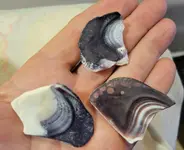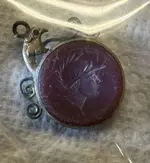D
Deleted member 140734
Guest
- #1
Thread Owner
Eroding from the soil in banks near oceans edge I found a handful of purple quahog shell corners used by Native Americans in wampum bead production. How can I be so sure? They come from an area with cores, microliths, pottery, and stone tools. Early Dutch accounts record wampum-making activity in this area.
The purple region of the hard-shell clam constitutes only about a quarter of the top half of the shell. The purple beads were more desirable and had a much higher value than the white. The purple section was cut away. We still have quahog clams around but not as large as they once were. Quahogs can live for decades. Our scallop populations have severely declined in recent years.
The purple region of the hard-shell clam constitutes only about a quarter of the top half of the shell. The purple beads were more desirable and had a much higher value than the white. The purple section was cut away. We still have quahog clams around but not as large as they once were. Quahogs can live for decades. Our scallop populations have severely declined in recent years.
Amazon Forum Fav 👍
Attachments
Upvote
11





